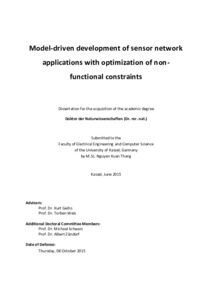| dcterms.abstract | Wireless sensor networks (WSNs) differ from conventional distributed systems in many aspects. The resource limitation of sensor nodes, the ad-hoc communication and topology of the network, coupled with an unpredictable deployment environment are difficult non-functional constraints that must be carefully taken into account when developing software systems for a WSN. Thus, more research needs to be done on designing, implementing and maintaining software for WSNs. This thesis aims to contribute to research being done in this area by presenting an approach to WSN application development that will improve the reusability, flexibility, and maintainability of the software.
Firstly, we present a programming model and software architecture aimed at describing WSN applications, independently of the underlying operating system and hardware. The proposed architecture is described and realized using the Model-Driven Architecture (MDA) standard in order to achieve satisfactory levels of encapsulation and abstraction when programming sensor nodes. Besides, we study different non-functional constrains of WSN application and propose two approaches to optimize the application to satisfy these constrains.
A real prototype framework was built to demonstrate the developed solutions in the thesis. The framework implemented the programming model and the multi-layered software architecture as components. A graphical interface, code generation components and supporting tools were also included to help developers design, implement, optimize, and test the WSN software.
Finally, we evaluate and critically assess the proposed concepts. Two case studies are provided to support the evaluation. The first case study, a framework evaluation, is designed to assess the ease at which novice and intermediate users can develop correct and power efficient WSN applications, the portability level achieved by developing applications at a high-level of abstraction, and the estimated overhead due to usage of the framework in terms of the footprint and executable code size of the application. In the second case study, we discuss the design, implementation and optimization of a real-world application named TempSense, where a sensor network is used to monitor the temperature within an area. | eng |

